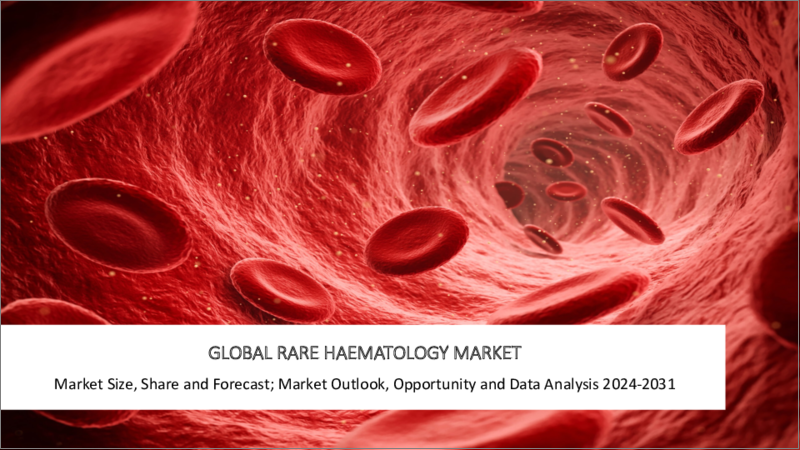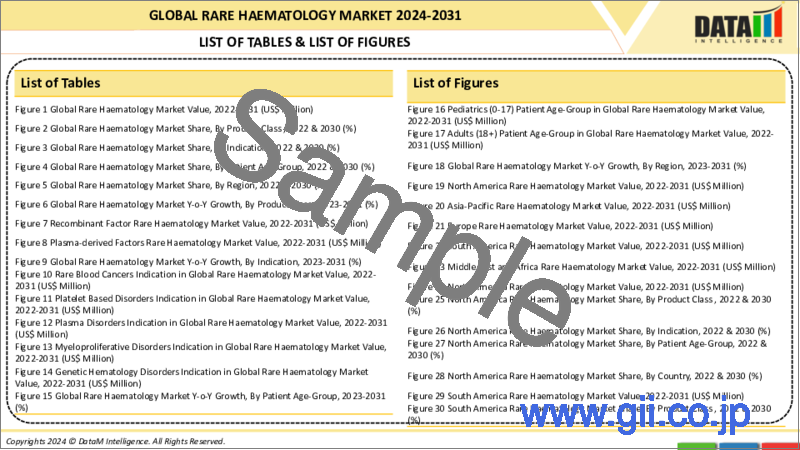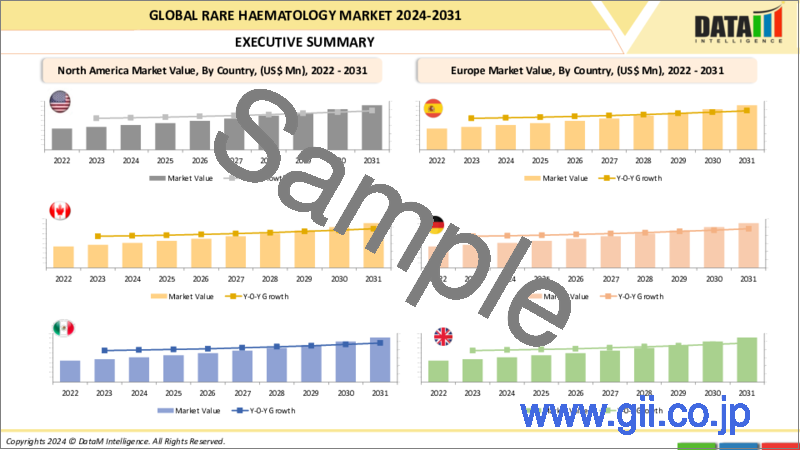|
|
市場調査レポート
商品コード
1179909
希少血液疾患の世界市場-2023-2030Global Rare Haematology Market - 2023-2030 |
||||||
|
● お客様のご希望に応じて、既存データの加工や未掲載情報(例:国別セグメント)の追加などの対応が可能です。 詳細はお問い合わせください。 |
|||||||
| 希少血液疾患の世界市場-2023-2030 |
|
出版日: 2023年01月05日
発行: DataM Intelligence
ページ情報: 英文 200 Pages
納期: 約2営業日
|
- 全表示
- 概要
- 目次
市場概要
世界の希少血液疾患市場規模は、予測期間(2023-2030年)に著しく成長するとされています。
希少な血液疾患を持つ人は少数派です。これらの疾患は、血小板、赤血球、白血球に影響を与え、酸素の運搬や感染症との闘いを困難なものにします。血球貪食性リンパ組織球症などの一部の疾患は、致命的な状態になることもあります。血液の病気には、がん性のものと非がん性のものがあります。非がん性の血液疾患の中で最も一般的なのは貧血です。
市場力学
世界の希少血液疾患市場を牽引する主な要因は、特定の血液疾患の発生率が上昇していることです。主なプレイヤーによる新規治療法の進歩・開発を促進するために、より多くの臨床試験が実施されています。
特定の血液疾患の発生率の上昇は、希少血液疾患市場の成長を促進する主要因です。
血液学者は、貧血、骨髄腫、白血病、鎌状赤血球症など、多数の血液疾患の発生が増加しているため、さまざまな検出手順に集中しています。また、比較的迅速な診断が要求されるため、正確な診断による治療プロセスの向上が求められています。また、各種血液疾患の診断の必要性が高まっていることも、診断能力の向上に拍車をかけています。
米国国立衛生図書館によると、2022年には85歳以上の高齢者の20%以上が罹患します。老人ホームの人口では、貧血が50~60%発生しています。鉄分、葉酸、ビタミンB12の不足などの食事不足が高齢者の貧血の主な原因であり、患者の約3分の1を占めています。さらに3分の1には、慢性炎症または腎不全があることが証明されています。そして、Statistaの調査によると、2021年には世界で約23万4,000人の血友病患者が確認されると推定されています。そして、その時点でさらに9万人がフォンウィルブランド病に罹患しています。出血を引き起こすこれら2つの遺伝性疾患は、血液が正しく凝固することを妨げています。これらの要因から、市場の成長は予測期間中も勢いを増すでしょう。
希少血液疾患の診断価格が高いため、市場の成長の妨げになると予想されます。
希少血液疾患市場は、高価格による制限に直面し、不利な償還政策も市場の成長を妨げる主要因となります。
COVID-19インパクト分析
ここ数ヶ月、大半の産業が不利な影響を受けています。これは、世界の規制機関による様々な予防的ロックダウンやその他の制限により、彼らのサプライチェーンや製造工程に大きな支障が生じたことに起因しています。市場も同様です。
さらに、多くの人々の一般的な経済状況がパンダミックによって大きな影響を受けているため、人々は不要不急の支出を予算から削減しようとする傾向が強まり、消費者需要が減少しています。これらの要因は、予測期間中、市場に悪影響を及ぼすと予想されます。しかし、関連する行政機関が医薬品の使用制限を解除した後、世界の希少疾病用血液検査市場は回復に向かうと予想されます。
目次
第1章 調査手法と調査範囲
- 調査手法
- 調査目的および調査範囲
第2章 市場の定義と概要
第3章 エグゼクティブサマリー
第4章 市場力学
- 市場影響要因
- 促進要因
- 特定の血液疾患の発生率の上昇
- 進歩促進のため、より多くの臨床試験が実施されている
- 抑制要因
- 診断費用の高騰が市場成長の妨げになることが予想されます。
- 機会
- 影響分析
- 促進要因
第5章 産業分析
- ポーターのファイブフォース分析
- サプライチェーン分析
- プライシング分析
- 規制分析
第6章 COVID-19の分析
- COVID-19の市場分析
- COVID-19以前の市場シナリオ
- COVID-19の現在の市場シナリオ
- COVID-19の後、または将来のシナリオ
- COVID-19の中での価格ダイナミクス
- 需要-供給スペクトラム
- パンデミック時の市場に関連する政府の取り組み
- メーカーの戦略的取り組み
- まとめ
第7章 製品クラス別
- リコンビナントファクター
- 血漿由来因子
- 半減期延長型
第8章 効能・効果別
- 希少血液がん
- 血小板関連疾患
- 血漿障害
- 骨髄増殖性疾患
- 遺伝性血液疾患
第9章 患者の年齢層別
- 小児科(0-17)
- 成人(18歳以上)
第10章 地域別
- 北米
- 米国
- カナダ
- メキシコ
- 欧州
- ドイツ
- 英国
- フランス
- イタリア
- スペイン
- その他欧州
- 南米
- ブラジル
- アルゼンチン
- その他の南米地域
- アジア太平洋地域
- 中国
- インド
- 日本
- オーストラリア
- その他アジア太平洋地域
- 中東・アフリカ地域
第11章 競合情勢
- 主な展開と戦略
- 企業シェア分析
- 製品ベンチマーク
- 注目の主要企業リスト
第12章 企業プロファイル
- Novartis AG
- 企業概要
- 製品ポートフォリオと説明
- 主なハイライト
- 財務概要
- Bristol-Myers Squibb Company
- Novo Nordisk A/S
- F. Hoffmann-La Roche Ltd
- Emmaus Medical, Inc.
- Pfizer Inc.
- Bayer AG
- Amgen Inc
- CSL Behring LLC.
- Vega Therapeutics Inc
第13章 希少血液疾患の世界市場-DataM
Market Overview
The global rare haematology market size was valued at US$ XX million in 2022 and is estimated to reach US$ XX million by 2030, growing at a CAGR of XX% during the forecast period (2023-2030).
A small number of individuals have rare blood diseases. They can impact platelets, red blood cells, or white blood cells, which makes it challenging to transfer oxygen and fight infections. A few conditions, such hemophagocytic lymphohistiocytosis, can be fatal. Cancerous and non-cancerous blood diseases both exist. The most prevalent non-cancerous blood condition is anemia.
Market Dynamics
The major factors driving the global rare haematology market are the rising incidence of certain blood diseases. More clinical trials are being conducted to promote progress and developing of novel treatments by the key players.
The rising incidence of certain blood diseases is the prime factor driving the growth of the rare haematology market.
Hematologists are concentrating on various detection procedures due to the rising occurrence of numerous blood disorders such as anemia, myeloma, leukemia, and sickle cell anemia. Hematologists are looking for improved treatment processes through accurate diagnosis processes as the requirement for conducting relatively rapid diagnosis processes is becoming the order of the day. Hematologists' attention to improving their diagnostic abilities has been further prompted by the increased necessity to identify various blood disorders.
More than 20% of those over the age of 85 are affected, according to the National Library of Health, U.S., 2022. In the population of nursing homes, anemia occurs 50% to 60% of the time. A dietary deficit, such as a lack of iron, folate, or vitamin B12, is the main cause of anemia in the elderly, accounting for about one-third of patients. There is proof of chronic inflammation or renal failure in another third of the individuals. And Statista research estimates that around 234 thousand hemophilia cases will be confirmed globally in 2021. And 90,000 more persons had von Willebrand disease at that time. These two hereditary illnesses that cause bleeding prevent blood from clotting correctly. Due to these factors, the market's growth will continue to pick up steam during the forecast timeframe.
Due to the high price of diagnosing rare haematology is expected to hamper the market's growth.
The rare haematology market will face limitations due to the high price of the disease, and unfavorable reimbursement policies are also a key factor hindering the growth of the market.
COVID-19 Impact Analysis
The majority of industries have had unfavorable effects in recent months. This can be ascribed to major interruptions in their supply chains and manufacturing processes due to global regulatory agencies' various precautionary lockdowns and other restrictions. The market is no different.
Additionally, consumer demand has decreased as people have become more motivated to cut non-essential spending from their budgets as the general economic situation of most people has been badly impacted by the pandamic. The above factors are anticipated throughout the forecast period to impact the market negatively. However, the global rare hematology market is anticipated to rebound after the relevant governing bodies start pharmaceuticals lift such imposed lockdowns.
Segment Analysis
The adults segment is expected to grow at the fastest CAGR during the forecast period (2022-2029)
The blood clots incorrectly as a result of hemophilia, an inherited bleeding disorder. Both spontaneous bleeding and bleeding after an accident or surgery may come from this. Hemophilia A primarily affects men, while it can also affect women. Hemophilia A affects about 1 in 5,000 newborns. A severe type of hemophilia A affects about 60% of those who suffer from it.
According to projections made by the American Cancer Society, there will be roughly 20,050 new cases of acute myeloid leukemia (AML) in the state in 2022, most of which will affect adults. AML will cause 11,540 deaths, almost all of which will be in adults.
According to the Indian Express News article from April 2019, approximately 80% of Indians with dangerous blood illness are believed to go undiagnosed since there aren't adequate diagnostic facilities in remote locations, despite advancements in medical technology for hemophilia treatment. Ahead of World Hemophilia Day on April 17, physicians projected that India, with about 200,000 cases, has the second-highest population of individuals with hemophilia. This chronic bleeding illness prevents blood from clotting. This opens up a large market opportunity and will spur growth in the upcoming years.
Geographical Analysis
North America holds the largest market share in the global rare haematology market.
North America dominates the global Rare Haematology market primarily due to its large population, excellent medical infrastructure, and high-income levels. The market is expected to grow at a relatively moderate pace during the forecast period. Due to the growing elderly population and rising prevalence of rare blood disorders, the North American market for rare hematological disorders would rise. Additionally, the industry will experience a rapid expansion in the coming years due to the major pharmaceutical companies' research initiatives to create new drugs.
Numerous Americans, including millions of people, are carriers of genes that can lead to blood diseases like sickle cell disease and hemophilia, according to the Office of Disease Prevention and Health Promotion's 2019 report. The goal of Healthy People 2030 is to improve the health and standard of living of people with blood diseases.
In the U.S., sickle cell disease, a blood condition, affects more than 100,000 people. Blood transfusions can help avoid and treat problems, and interventions, such as plans to use more hydroxyurea, can improve the health outcomes of patients with sickle cell disease. The regional expansion will be further aided by improved healthcare infrastructure, rising healthcare spending, and helpful government efforts. For instance, scientists funded by the National Heart, Lung, and Blood Institute (NHLBI) in June 2021 discovered life-saving therapies for hemophilia patients and are currently working on gene therapy options to treat the condition.
Competitive Landscape
The Rare Haematology market is moderately competitive with local and global companies' presence Novartis, Bristol-Myers Squibb Company, Novo Nordisk A/S, F. Hoffmann-La Roche Ltd, Emmaus Medical, Inc., Pfizer Inc., Bayer AG, Amgen Inc, CSL Behring LLC and more. The key players are adopting various growth strategies such as product launches, mergers & acquisitions, partnerships, and collaborations, contributing to the market's growth. For instance, in December 2022, The 64th American Society of Hematology (ASH) Annual Meeting saw the introduction and public presentation of VGA039, a first-in-class antibody treatment developed by Vega Therapeutics, Inc., a clinical stage biotechnology company.
Novartis AG.
Overview: A healthcare company named Novartis AG (Novartis) specializes in developing, producing, and marketing prescription and over-the-counter medicines and eye care products. It offers medicines for infections, cancer, cardiovascular disease, dermatological issues, neurological disorders, ophthalmic and respiratory illnesses, and cancer. Through Sandoz, the business provides biosimilars and generic medications. Through The Novartis Institutes for BioMedical Research, Novartis conducts research in several illness areas (NIBR).
Product Portfolio:
Novartis drug Promacta: PROMACTA is indicated in combination with standard immunosuppressive therapy (IST) for the first-line treatment of adult and pediatric patients 2 years and older with severe aplastic anemia. PROMACTA is indicated for the treatment of patients with severe aplastic anemia who have had an insufficient response to immunosuppressive therapy.
Theglobal Rare Haematology market report would provide access to approx.: 45 + market data table, 40 + figures and 200 (approximate) pages.
Table of Contents
1. Methodology and Scope
- 1.1. Research Methodology
- 1.2. Research Objective and Scope of the Report
2. Market Definition and Overview
3. Executive Summary
4. Market Dynamics
- 4.1. Market Impacting Factors
- 4.1.1. Drivers
- 4.1.1.1. The rising incidence of certain blood diseases
- 4.1.1.2. More clinical trials are being conducted to promote progress
- 4.1.2. Restraints:
- 4.1.2.1. Due to the high price of diagnosing is expected to hamper the market's growth.
- 4.1.3. Opportunity
- 4.1.4. Impact Analysis
- 4.1.1. Drivers
5. Industry Analysis
- 5.1 Porter's Five Forces Analysis
- 5.2 Supply Chain Analysis
- 5.3 Pricing Analysis
- 5.4 Regulatory Analysis
6. COVID-19 Analysis
- 6.1. Analysis of Covid-19 on the Market
- 6.1.1. Before COVID-19 Market Scenario
- 6.1.2. Present COVID-19 Market Scenario
- 6.1.3. After COVID-19 or Future Scenario
- 6.2. Pricing Dynamics Amid Covid-19
- 6.3. Demand-Supply Spectrum
- 6.4. Government Initiatives Related to the Market During the Pandemic
- 6.5. Manufacturer's Strategic Initiatives
- 6.6. Conclusion
7. By Product Class
- 7.1. Introduction
- 7.1.1. Market Size Analysis and Y-o-Y Growth Analysis (%), By Product Class
- 7.1.2. Market Attractiveness Index, By Product Class
- 7.2. Recombinant factor
- 7.2.1. Introduction
- 7.2.2. Market Size Analysis US$ Million, 2020-2029 and Y-o-Y Growth Analysis (%), 2021-2029
- 7.3. Plasma-derived factors
- 7.4. Extended Half-Life
8. By Indication
- 8.1. Introduction
- 8.1.1. Market Size Analysis and Y-o-Y Growth Analysis (%), By Indication
- 8.1.2. Market Attractiveness Index, By Indication
- 8.2. Rare blood cancers
- 8.2.1. Introduction
- 8.2.2. Market Size Analysis US$ Million, 2020-2029 and Y-o-Y Growth Analysis (%), 2021-2029
- 8.3. Platelet based disorders
- 8.4. Plasma disorders
- 8.5. Myeloproliferative disorders
- 8.6. Genetic hematology disorders
9. By Patient Age-Group
- 9.1. Introduction
- 9.1.1. Market Size Analysis and Y-o-Y Growth Analysis (%), By Patient Age-Group
- 9.1.2. Market Attractiveness Index, By Patient Age-Group
- 9.2. Pediatrics (0-17)
- 9.2.1. Introduction
- 9.2.2. Market Size Analysis US$ Million, 2020-2029 and Y-o-Y Growth Analysis (%), 2021-2029
- 9.3. Adults (18+)
10. By Region
- 10.1. Introduction
- 10.1.1. Market Size AnalysisUS$ Million, 2020-2029 and Y-o-Y Growth Analysis (%), 2021-2029, By Region
- 10.1.2. Market Attractiveness Index, By Region
- 10.2. North America
- 10.2.1. Introduction
- 10.2.2. Key Region-Specific Dynamics
- 10.2.3. Market Size Analysis and Y-o-Y Growth Analysis (%), By Product Class
- 10.2.4. Market Size Analysis and Y-o-Y Growth Analysis (%), By Indication
- 10.2.5. Market Size Analysis and Y-o-Y Growth Analysis (%), By Patient Age-Group
- 10.2.6. Market Size Analysis and Y-o-Y Growth Analysis (%), By Country
- 10.2.6.1. U.S.
- 10.2.6.2. Canada
- 10.2.6.3. Mexico
- 10.3. Europe
- 10.3.1. Introduction
- 10.3.2. Key Region-Specific Dynamics
- 10.3.3. Market Size Analysis and Y-o-Y Growth Analysis (%), By Product Class
- 10.3.4. Market Size Analysis and Y-o-Y Growth Analysis (%), By Indication
- 10.3.5. Market Size Analysis and Y-o-Y Growth Analysis (%), By Patient Age-Group
- 10.3.6. Market Size Analysis and Y-o-Y Growth Analysis (%), By Country
- 10.3.6.1. Germany
- 10.3.6.2. U.K.
- 10.3.6.3. France
- 10.3.6.4. Italy
- 10.3.6.5. Spain
- 10.3.6.6. Rest of Europe
- 10.4. South America
- 10.4.1. Introduction
- 10.4.2. Key Region-Specific Dynamics
- 10.4.3. Market Size Analysis and Y-o-Y Growth Analysis (%), By Product Class
- 10.4.4. Market Size Analysis and Y-o-Y Growth Analysis (%), By Indication
- 10.4.5. Market Size Analysis and Y-o-Y Growth Analysis (%), By Patient Age-Group
- 10.4.6. Market Size Analysis and Y-o-Y Growth Analysis (%), By Country
- 10.4.6.1. Brazil
- 10.4.6.2. Argentina
- 10.4.6.3. Rest of South America
- 10.5. Asia Pacific
- 10.5.1. Introduction
- 10.5.2. Key Region-Specific Dynamics
- 10.5.3. Market Size Analysis and Y-o-Y Growth Analysis (%), By Product Class
- 10.5.4. Market Size Analysis and Y-o-Y Growth Analysis (%), By Indication
- 10.5.5. Market Size Analysis and Y-o-Y Growth Analysis (%), By Patient Age-Group
- 10.5.6. Market Size Analysis and Y-o-Y Growth Analysis (%), By Country
- 10.5.6.1. China
- 10.5.6.2. India
- 10.5.6.3. Japan
- 10.5.6.4. Australia
- 10.5.6.5. Rest of Asia Pacific
- 10.6. Middle East and Africa
- 10.6.1. Introduction
- 10.6.2. Key Region-Specific Dynamics
- 10.6.3. Market Size Analysis and Y-o-Y Growth Analysis (%), By Product Class
- 10.6.4. Market Size Analysis and Y-o-Y Growth Analysis (%), By Indication
- 10.6.5. Market Size Analysis and Y-o-Y Growth Analysis (%), By Patient Age-Group
11. Competitive Landscape
- 11.1. Key Developments and Strategies
- 11.2. Company Share Analysis
- 11.3. Products Benchmarking
- 11.4. List of Key Companies to Watch
12. Company Profiles
- 12.1. Novartis AG
- 12.1.1. Company Overview
- 12.1.2. Product Portfolio and Description
- 12.1.3. Key Highlights
- 12.1.4. Financial Overview
- 12.2. Bristol-Myers Squibb Company
- 12.3. Novo Nordisk A/S
- 12.4. F. Hoffmann-La Roche Ltd
- 12.5. Emmaus Medical, Inc.
- 12.6. Pfizer Inc.
- 12.7. Bayer AG
- 12.8. Amgen Inc
- 12.9. CSL Behring LLC.
- 12.10. Vega Therapeutics Inc
LIST NOT EXHAUSTIVE
13. Global Rare Haematology Market - DataM
- 13.1. Appendix
- 13.2. About Us and Application
- 13.3. Contact Us




